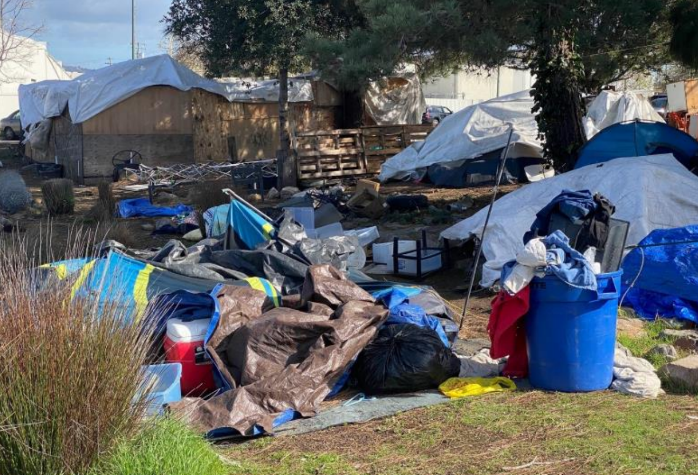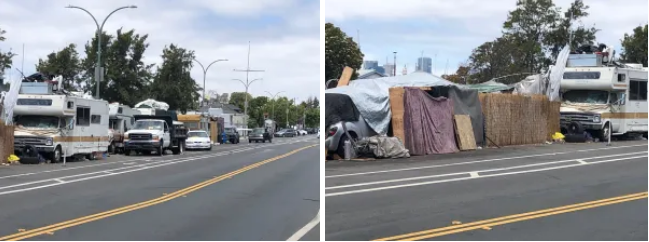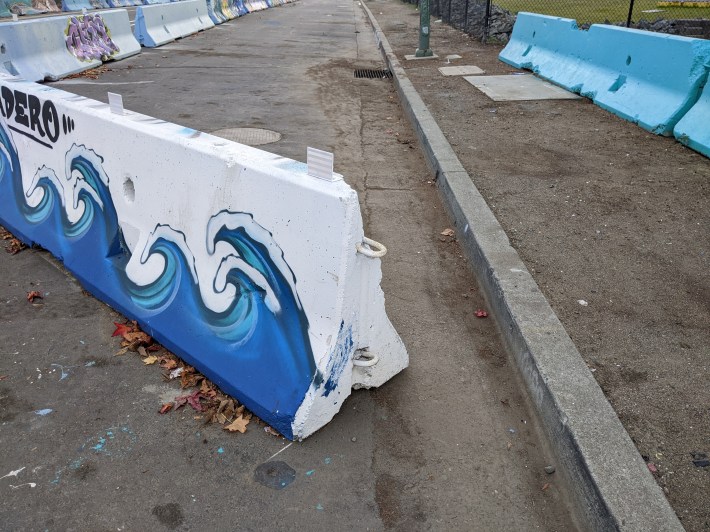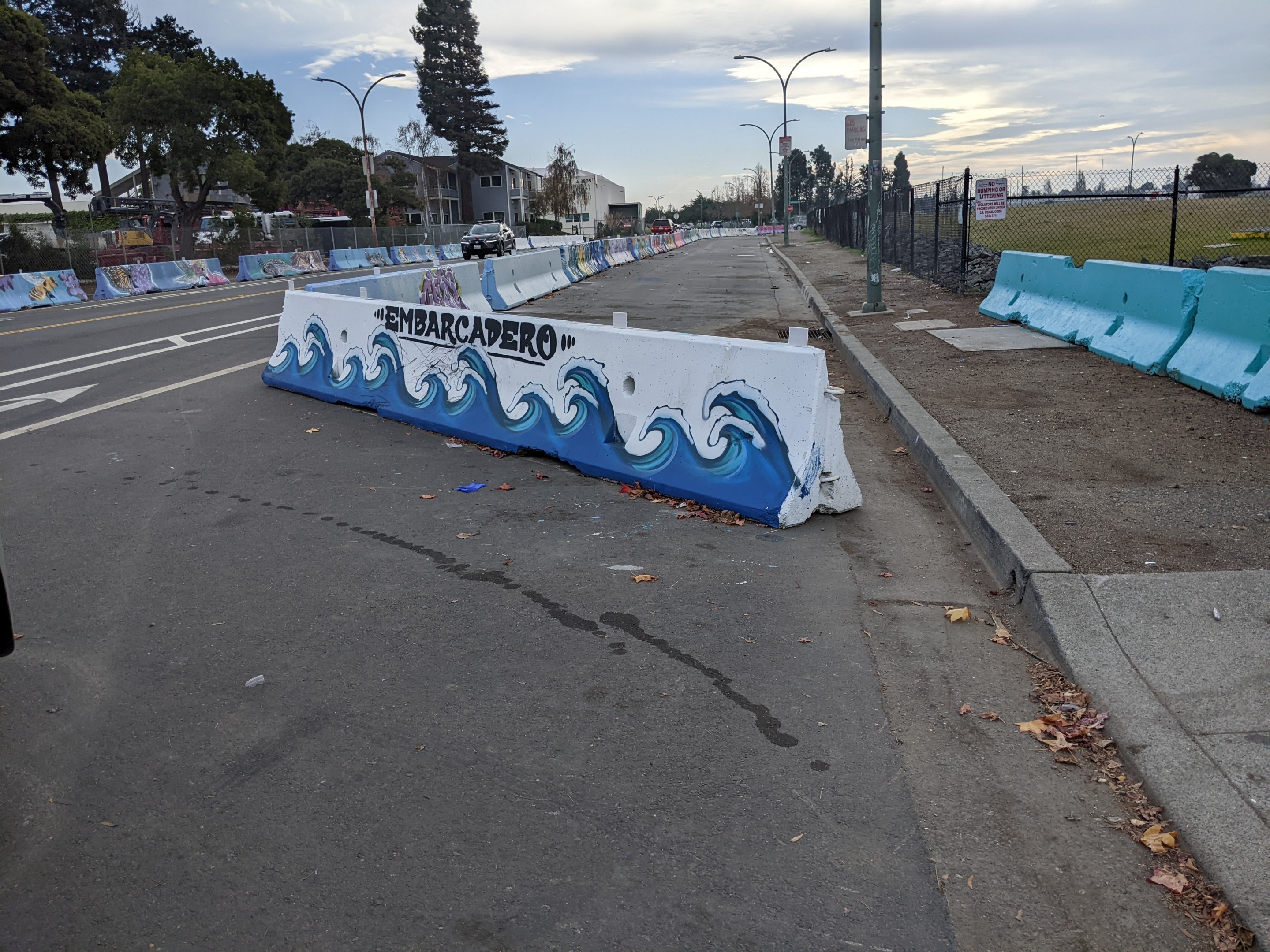Note: GJEL Accident Attorneys regularly sponsors coverage on Streetsblog San Francisco and Streetsblog California. Unless noted in the story, GJEL Accident Attorneys is not consulted for the content or editorial direction of the sponsored content.
Streetsblog readers may recall that when Oakland opened a new bridge on the Embarcadero over the estuary channel, they put the steel crash barriers on the right side of the bike lane. They wanted the bike lane to double as a breakdown lane for cars. In other words, if a cyclist gets crushed to death every now and then, that's okay--as long as a broken-down car has some place to pull over so it doesn't cause the occasional traffic backup.
That seemed to be the situation repeating itself a little over a mile down Oakland's Embarcadero where it meets the bridge to Coast Guard Island. AC Transit Board member and safe-streets advocate Jean Walsh understandably groused about it on social media:
the barrier is on the wrong side of the lane. it should be separating the bike lane from the cars!
— NoBe Local - Miami Beach (@NobeResistance) December 17, 2021
Streetsblog couldn't have put it better than NoBeLocal or Michael Beauregard on Twitter, who wrote: "dude they were SO close."
But the valid comments all assumed it was the City of Oakland or some other agency that should know better that was responsible for these barriers. In reality, the situation is tragic and complex. As Streetsblog confirmed, "OakDOT was definitely not involved. It was an RV parking response installation, not a transportation project," explained Bike East Bay's Robert Prinz.
Here's the background: in 2005, local neighbors dedicated Union Point Park, which is right across from the location:

But it soon became a homeless encampment. As Oakland Marina's Harbor Master Brock de Lappe told Streetsblog, crime soon followed. "There have been four murders on this short stretch of the Oakland Embarcadero since the end of February," he told the San Francisco Bay Conservation and Development Commission (BCDC), which has jurisdiction over the area, at a hearing about the issue.

He also told Streetsblog that neighbors pleaded with the City of Oakland to find supportive services for the people in the park, but to no avail. "The city claims it's overwhelmed and can't deal with it, so nothing got done.' Finally, "the BCDC issued a cease-and-desist notice to the city of Oakland, which required everybody to be removed from the park by Feb 12." He said on March 12 of this year it was done.
But at this point the encampment and the trash its residents produced wasn't just in the park; it had moved onto the Embarcadero itself. "Often vehicles were double-parked extending into the street and bike lane," said de Lappe. That was removed by the city too, since it also fell under the BCDC mandate, and the people were forced out.

According to Chris McKay of the Embarcadero Neighborhood Association, they realized things would soon revert without transitional housing and enforcement from the city--which they already knew they weren't going to get. The association decided to buy second-hand K-rails and to pay for their installation along the Embarcadero, in front of the park. His hope was to emulate what Alameda has done with its cross-Alameda trial project across the estuary. "When you look at Alameda and what they did on Clement--but they have enforcement. We don't."
Some readers will see this as a neighborhood association being uncompassionate. But even an advocate for the unhoused opined to Streetsblog that this is more complicated. "I'm trying to push the public health and safety crisis to be recognized equally or alongside the homeless crisis," wrote Marquita Price with the East Oakland Collective, in an email about this stretch of the Embarcadero. She stressed that her opinions don't represent her organization's official policy, but that "as one who walked and biked for the past five years in between not having a car, I've experienced firsthand the complexities with having compassion for the unhoused living alongside transportation infrastructure." And, in Streetsblog's view, the city needs to keep creating more safe parking sites where people can live in RVs without creating a hazard to themselves and others.
McKay, meanwhile, said they hired artists to paint one side of the barriers--the sides that faced the street--and allowed taggers to get the other side, in a kind of unspoken bargain.

McKay also told Streetsblog that he wants to improve the situation for pedestrians and people on bikes and try to fix the problem cited by Walsh.

The barriers weigh around 8,000 pounds each and require a forklift to move. And McKay and de Lappe are concerned if they moved them all the way over to the left side of the bike lane, where it's currently striped out in the roadway, it will trigger the city or another agency to remove them altogether. Given how the steel barriers were designed by the city on the aforementioned bridge up the street, their concerns are probably valid.
However, McKay said after the holidays he wants to meet with advocates and figure out how to angle the barriers at the ends of the area enough so it's permeable to cyclists. That would, in effect, create a fully protected bike lane.
"Maybe we can put up some signs for bikes too," he told Streetsblog. Perhaps that really could be the seed that grows into Oakland's equivalent of the cross-Alameda trail. "I think we can figure this out. I'm in favor of anything for pedestrians and cyclists."






